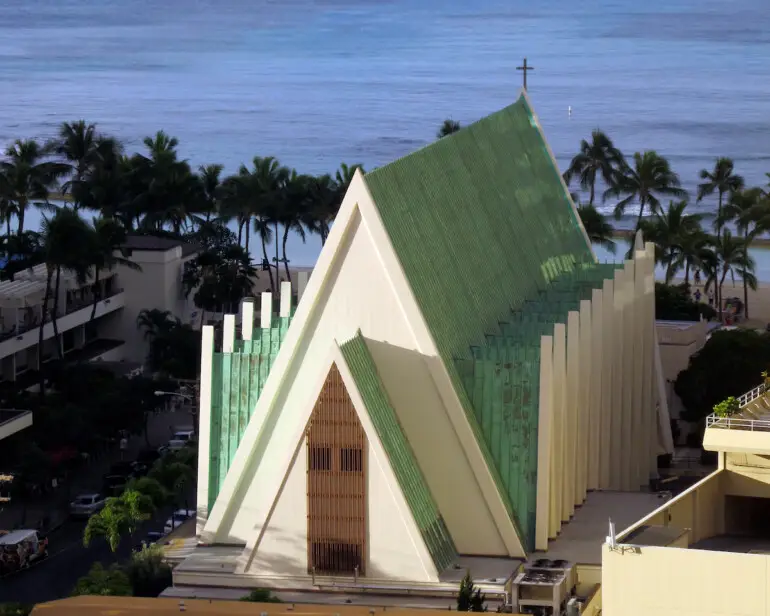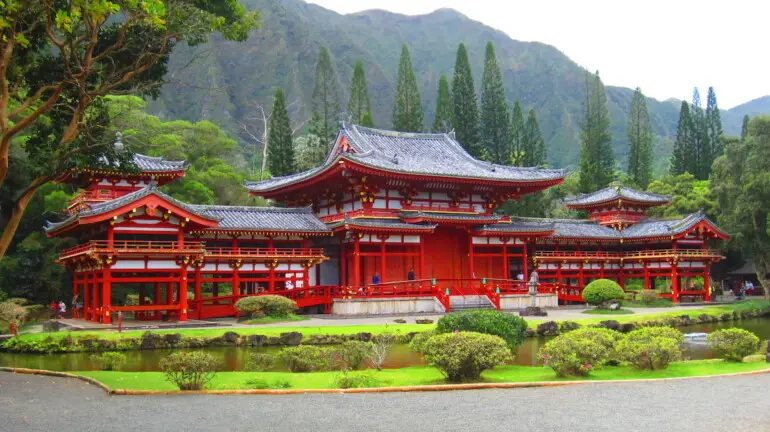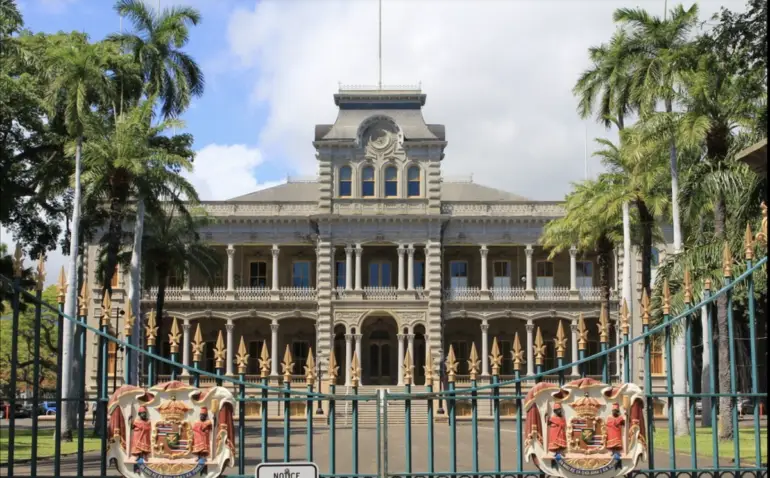Hawaiian architecture reflects a complex story of the evolution of culture and ethnic influences that built Hawai’i’s history beyond the time of Native Hawaiians’ first contact with the Western world. This story starts in 1778 with James Cook, early European traders, whalers, and fur trappers from Canada. Then, missionaries from New England and French Catholics came with their religious colonization, and eventually, Chinese, Japanese, and Portuguese plantation laborers. Today, Oahu, known as “the Gathering Place,” is the most populous island, and its architecture reflects the unique combination of cultures. Here are some must-see architectural wonders on Oahu.
Royal Hawaiian

The Royal Hawaiian was one of the first hotels established in Waikiki. It opened its doors in 1927 and is recognized today as one of Hawaiian tourism’s most luxurious and famous hotels. Situated on the sandy beaches of Waikiki, its bright pink concrete stucco facade and Spanish/Moorish architecture have earned this hotel the nickname commonly known as the “Pink Palace of the Pacific.” The architects were Warren and Wetmore of New York, and the design was influenced by the Hollywood Film Star Rudulpho Valentino’s Arabian movies. The Royal Hawaiian is hard to miss in the center of Waikiki. Make sure to take some time to wander through its pink halls that feature Hawaiian artifacts or take in its pink splendor from Waikiki Beach.
Saint Augustine by the Sea

Saint Augustine by the Sea Catholic Church sits on Kalākaua Avenue in Waikiki with a splendid view of the crystal clear waters and Queens surf break. It was the third parish church established in the Hawai’i Catholic church and was founded in 1854. Today, the church is home to the Damien Museum, featuring relics of Saint Damien of Molokai and other historical artifacts. The church’s neo-Gothic style is defined by dramatic stained glass windows, a clean white facade highlighted by a turquoise roof, and pointed “arches.” There is some debate about what these arches represent; one thought is they resemble praying hands, while others believe the shape carries on from the Polynesian/Hawaiian A-Frame. Saint Augustine by the Sea is easy to spot from the Lē’ahi (Diamond Head) end of the Waikiki strip.
Byodo-In Temple

The Byodo-In Temple is a non-denominational Buddhist temple in the Valley of the Temples Memorial Park. The temple was dedicated in 1968 to commemorate the 100th anniversary of the first Japanese immigrants to Hawai’i and is a replica of a 900-year-old Buddhist temple at Uji, Kyoto Prefecture, Japan. The green backdrop of the Ko’olau mountain range on Oahu’s East side emphasizes the stark red structures. The site has an 18 ft tall statue of the Lotus Buddha, a three-ton brass peace bell, koi-ponds, and vibrant gardens. To visit the temple, you can purchase tickets for a tour or attend an event listed here.
Shangri La

Where black lava rock meets the light blue Pacific near Lē’ahi (Diamond Head) sits the Shangri La Museum of Islamic Art, Culture & Design. The former home of Doris Duke, a tobacco heiress in the 1930s, then called “the richest girl in the world,” is a prime example of Islamic-influenced 1930s modernist architecture by Marion Sims Wyeth in a tropical landscape. Duke started construction on Shangri La in 1936 after her 1935 honeymoon that took her through the Islamic world. The house was finished in 1938, and for almost 60 years, Duke collected and commissioned artworks for the space, eventually collecting over 4,000 pieces. Today, Shangri La is available for guided tours from the Honolulu Museum of Art in collaboration with the Doris Duke Foundation for Islamic Art (DDFIA).
Liljestrand House

Along Tantalus Drive, the Liljestrand House, designed by Vladimir Ossipoff for Betty and Howard Lijestrand, overlooks downtown Honolulu. The house, classified as mid-twentieth-century Hawaiian modern, was finished in 1952 and is deemed one of Ossipoff’s “most intricate and widely publicized domestic commissions.” Ossipoff is best known for designs that are seamless integrations of a building site, circularity, a creative mix of modern and natural materials, and intelligent management of views. Today, the Liljestrand Foundation owns the Liljestrand House and holds public tours, events, and charitable, cultural, and educational activities to preserve the house. In 2008, it was listed on the National Register of Historic Places. Make sure to check their website for information about tours and events.
Hawai’i State Capitol Building

The Hawai’i State Capitol is located in downtown Honolulu and was built to replace the ‘Iolani Palace as the formal statehouse. The unique design is an American adaptation of the Bauhaus architecture, deemed “Hawai’i international architecture.” It was commissioned and dedicated by John A. Burns, the second Governor of Hawai’i, and opened on March 15, 1969. The distinct architectural features of the capital symbolize the natural aspects of Hawai’i. The reflecting pool surrounding the building represents the Pacific Ocean, and the two legislative chambers are cone-shaped and meant to convey the volcanoes that formed the Hawaiian islands. Eight columns, symbolizing the eight main Hawaiian islands, comprise the perimeter of the building and are shaped to represent royal palm trees. The building is an open-air design; from the center, the chandeliers from both legislative chambers are seen through the glass walls. The chandeliers symbolize the sun and the moon. Open to the public for walking through, stop by and marvel at the architectural intricacies that make up Hawai’i’s Capitol.
‘Iolani Palace

The ʻIolani Palace, known in Hawaiian as Hale Aliʻi ʻIolani, was the royal residence of the leaders of the Kingdom of Hawai’i from 1845 to 1893 and is the only royal palace on U.S. soil. After the monarchy was overthrown in 1893, the building was used as the capitol building for the Provisional Government, Territory, Republic, and State of Hawaiʻi until 1969. The unique architecture of the palace is known as American Florentine, and at the time, it cost a fortune of over $340,000 to build (about $10,310,207 in 2022 dollars). The palace is open daily for guided tours, where you will see some of the most famous features, like the grand staircase made of Koa Wood, an 1848 portrait of King Louis Philippe of France, the Ali’i (royal) music room, and more.
